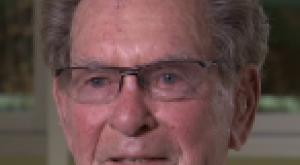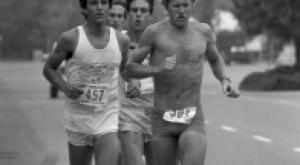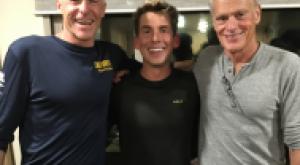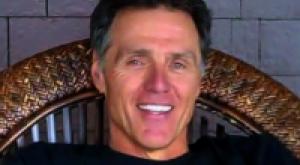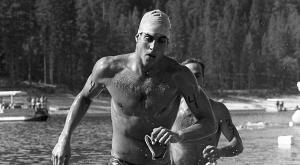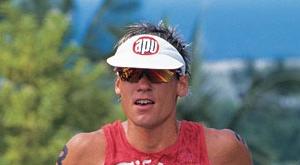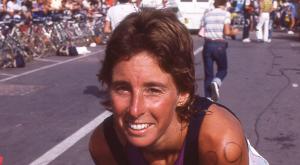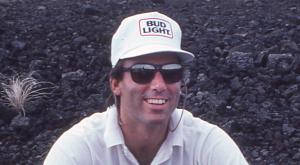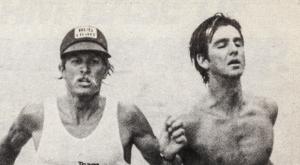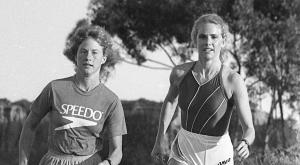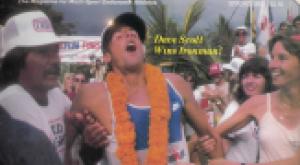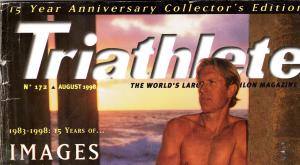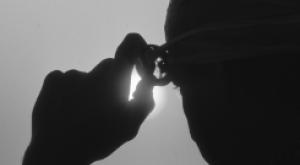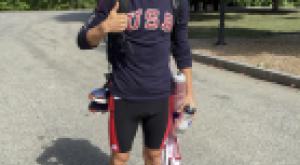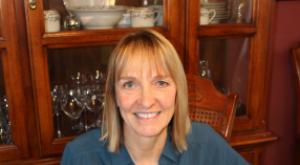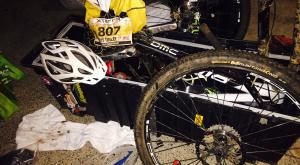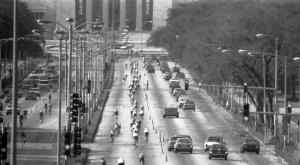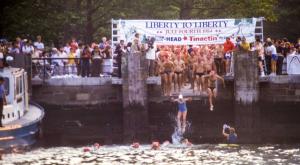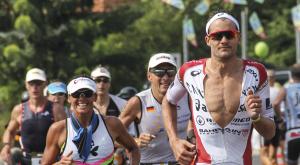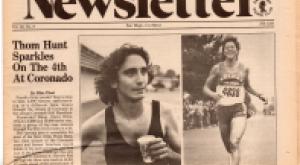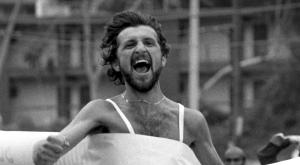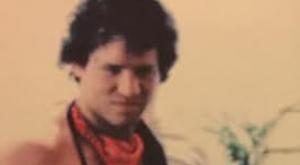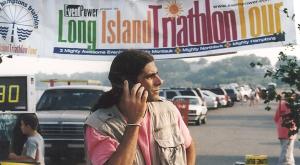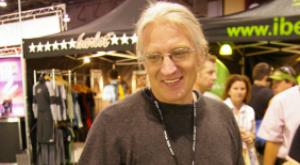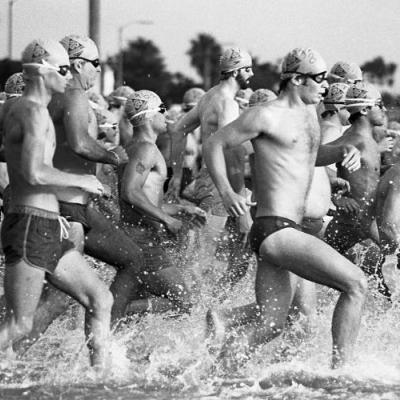
The first thing you need to know about the second professional triathlon ever held was that it wasn’t very professional. It was touted as “the Los Angeles stop of the 1982 U.S. Triathlon Series” but it wasn’t held in Los Angeles. Two weeks after USTS’ inaugural San Diego race (staged at Del Mar’s Torrey Pines Beach), event organizers, Carl A. Thomas and Jim Curl, moved their show north on the SoCal coast to Marine Stadium, a cement and myler-lined drainage ditch on the southern rim of Long Beach, California. While the Torrey Pines event opened the doors, the Long Beach/LA stop created a line to get in.
Before the Army Corps of Engineers built an eighteen hundred foot long rock and stone jetty outside of Pt. Fermin on the southwest edge of Los Angeles in the 1940s, Long Beach existed as a prime and protected enclave of Southern California beach habitat. People swam and surfed and sunned themselves on the pre-groovy, post WWII beaches. Soon enough the Wilmington Oil Field within the bowels of Long Beach became the 4th richest oil field in the U.S. and water quality gave way to corporate gain. By the time Carl and Jim went to the Long Beach Board of Supervisors requesting a permit to allow a thousand bodies to swim in Marine Stadium, the culture of sweat for dollar signs was well endowed. The backstory of the event, however, offers a unique glimpse into whom and what the sport of triathlon was to become.
Scott Molina, the event’s winner, remembers fondly. “My vague recollection of how I got down to the race from my Pittsburg, California home was that my buddy and training partner, Dean Harper and I drove down the eight hours to get there the night before. Since we didn’t have any ‘discretionary income’ (never mind having any real income at all) we couldn’t afford more than one night’s motel room. So we planned on driving back straight after the awards ceremony.”
Molina and his limited means signified the way many athletes looked at the sport then. No one had any real confidence that a living wage could be earned from the sport. But Carl and Jim had a hunch what a successful event in the long palm tree’d shade of Hollywood might do for the professional opportunities of the triathlon proletariat. This LA, Baby, and if any event has an El Dorado-ish intent, it was the Long Beach, USTS of 1982.
I have this lingering image of women’s winner, Kathleen McCartney, crossing the finish line and quickly disappearing into a pop-up tent. I had been summarily dismissed by Molina, finishing a full two minutes behind him for second place. But as I lingered in the bridesmaid of the few paparazzi and San Diego’s Running & Triathlon News (insert article link here), McCartney emerged from the tent wearing a short white skirt, matching hair ribbons, and Dorothy-red pumps. Not a drop of dried sweat on her thin tan body. It was one of the greatest transitions in the sport’s history; a narrative that extends into the 2012 Ironman and beyond.
Other transitions were catalyzed for Molina, Curl, and Thomas. For Scott, who had been working two jobs in 1982—one as a clerk at Dave’s Liquor and another as a short-order cook at Kmart—the win meant more than the $500 check he was awarded.
“Look, I was interviewed for several prime-time newscasts to be aired that evening along with several big newspapers,” Scott remembers. “I won $500 in prize money and all of this was a huge boost to my confidence as I continued to search for a pathway to earn a living through endurance sport. Prior to this race, my father-in-law rightfully questioned my spending so much time, money, and energy dedicated to the quest of being a pro athlete in a way that no one on the planet had ever done previously.”
While the amount seems paltry now, what it did was launch Molina’s resolve which became the capstone of his storied career. “Of greater significance to me,” Scott recollects, “was the feeling that I’d somehow found my calling in life. The sport had been launched into the mainstream in a new way and I was determined to be a part of that.”
In hindsight I am struck that San Diego USTS 1982 winner, Dave Scott was not there. Neither was Mark Allen. But then I recall that all of us are gainfully (or mostly) employed. (I had missed the awards ceremony at the SD event because I had to get back to work.) It the Molina and McCartney show with stand-in from Tinley and Moss.
Organizers Thomas and Curl situate their critique somewhere between amazement, pride, and disgust. “It was a Cuisinart start with 1000 bodies aimed at one buoy 100 yards out,” Thomas remembers. “But we made do. I remember being in the lead vehicle with a group of college-aged volunteers and we came upon a locked gate. This was quickly sorted out,” he winks, “and the lead cyclists never know.”
Co-race director, Jim Curl, is less cavalier, perhaps taking a longer view in arrears. “After that event, a lot of people jumped into the triathlon pool. Carl and I knew we’d be able to stage the next three events that summer--San Francisco (actually it was in Livermore), Portland, and Seattle. We hadn’t killed anybody yet and sponsors were sniffing around. “
“What about that course, Jim?”
“Funky water. Bike paths and flood control channels. Broken glass everywhere. Not enough water on the run. A few boxes of orange slices at the end. But for 95% of the field, this was their first triathlon. They didn’t know any better. It was great!”

